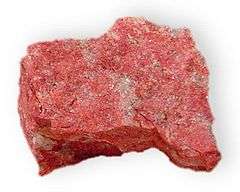Thulite
| Thulite | |
|---|---|
|
Thulite from Leksvik, Norway. | |
| General | |
| Category | Mineral Variety |
| Formula (repeating unit) | (Ca,Mn)2Al3(SiO4)(Si2O7)O(OH) |
| Crystal system | Orthorhombic |
| Identification | |
| Color | Pink |
| Crystal habit | Massive |
| Cleavage | Perfect {010} imperfect {100} |
| Fracture | Uneven to conchoidal |
| Mohs scale hardness | 6.5 |
| Luster | Vitreous, pearly on cleavage surfaces |
| Streak | White or colorless |
| Specific gravity | 3.10-3.38 |
| Optical properties | biaxial positive |
| Refractive index | 1.69-1.70 |
| Birefringence | 0.006-0.018 |
| Pleochroism | Present, dichroism or trichroism depending on color. |
Thulite (sometimes called rosaline) is an translucent, crystalline or massive pink manganese-bearing variety of the mineral zoisite. Manganese substitutes for calcium in the structure with up to two percent Mn2+.[1] Thulite is often mottled with white calcite and occurs as veins and fracture fillings transecting many types of rock. In mineralogical literature, thulite may sometimes refer to any pink zoisite. Clinothulite is the manganese bearing variety of monoclinic clinozoisite.[2]
Thulite was first discovered at a place called Sauland in Telemark, Norway in 1820. It is named after the mythical island of Thule in the belief that the island is Norway. Thulite is used as a gemstone and carving material in the manufacture of jewellery and ornamental objects.
Thulite is also found in the Austrian Tyrol, in Mitchell County, North Carolina, and in Western Australia. A new, more recent find of high quality thulite was discovered near Riverside in Okanogan County, Washington, US.
References
- ↑ Deer, Howie and Zussman, An Introduction to the Rock Forming Minerals, Longman, 1966, p. 62, ISBN 0-582-44210-9
- ↑ http://www.mindat.org/min-27132.html Mindat - Clinothulite
